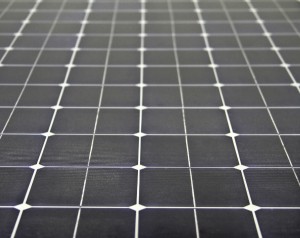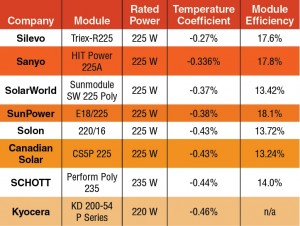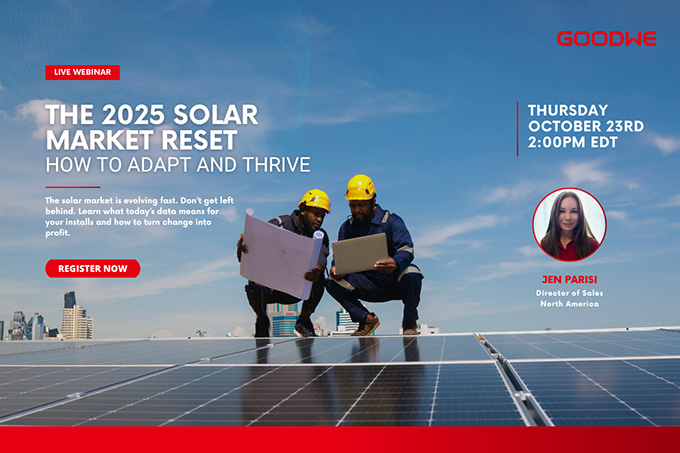More Bang for Your Buck
No developer builds a solar project aiming to get a so-so output of energy. Producing efficient cells that withstand the sun’s heat is a complicated puzzle that manufacturers are tackling head-on.
The sun is the main ingredient in solar energy production, but it’s also the most destructive element. As the sun shines down, solar panels heat up. When panels get hot, they produce less electricity. Often, the United States’ sunniest days come during the hottest months. Cooling a solar array with shading defeats the array’s purpose. It’s quite the paradox.
 Slowing the decay rate is an open race in the crystalline industry today, with a handful of cell and panel manufacturers making small gains. Production of real world-compatible cells — ones that can perform at temperatures higher than the 25° C (77° F) test rate — can push a company to a leadership position in this saturated market.
Slowing the decay rate is an open race in the crystalline industry today, with a handful of cell and panel manufacturers making small gains. Production of real world-compatible cells — ones that can perform at temperatures higher than the 25° C (77° F) test rate — can push a company to a leadership position in this saturated market.
HYBRID IDEAS
One relative newcomer diving into the U.S. solar market brings a combination of various technologies to produce a high performing cell. Silevo Solar was founded in 2007 in Silicon Valley by two executives formerly from Applied Materials Inc., a large equipment manufacturing company that specializes in semiconductor innovations for the LCD and solar industries. Zheng Xu brought a new idea for a hybrid solar cell technology, combining crystalline silicon, thin-film and semiconductor materials. Jianming Fu had a deep understanding of equipment, and the pair approached producing a device that could use off-the-shelf equipment to make a cost-effective, production-worthy technology.
The company spent its first few years focusing on research and development of its tunneling junction-type cell. Silevo received a technology grant from the government in 2009 for its “Triex” solar cell. Chris Beitel, vice president of business development and marketing for Silevo, says the technology is dedicated to producing a cell that performs well in real-world service environments.
“When solar panels are in the sun, they heat up. As they do that, they lose conversion efficiency or the ability to output as much power as they can in standard test conditions,” he says. “The tunneling junction device concept is really factored around getting good efficiency at a low cost but doing it with a low-temperature coefficient. The attribute of the device enables excellent energy harvest in real-world conditions.”
The cells are currently in production at Silevo’s manufacturing facility in Hangzhou, China, ready to enter the U.S. solar market, which is begging for temperature-resistant solar cells because of the country’s widespread climate. The same great cell working in Maine has a different experience in Texas.
 Panels list their peak power production at a certain wattage under specific testing conditions. Usually, panels are tested at 25° C (77° F). If panels are used in higher temperatures, as all states hit during summer months excluding Alaska (as determined by the National Oceanic and Atmospheric Administration), peak performance is often far below what is expected.
Panels list their peak power production at a certain wattage under specific testing conditions. Usually, panels are tested at 25° C (77° F). If panels are used in higher temperatures, as all states hit during summer months excluding Alaska (as determined by the National Oceanic and Atmospheric Administration), peak performance is often far below what is expected.
“There is really not an easy way to prevent the decay, and that’s why it’s important to assess the technology that you’re employing to make sure that you see those benefits factored into the overall economic picture of your installation,” Beitel says.
PREVENTING DECAY
The overwhelming majority of cells in use in the United States are crystalline and silicon-based, which have high-temperature coefficients. With traditional cells, the technology has temperature coefficients at -0.48 percent per degree Celsius. Basically, a cell degrades by half a percent for every 1° increase in temperature. Silevo has been third-party validated at -0.27 percent (according to spec sheets), effectively half the decay rate of traditional cells.
“What we’ve been able to do at Silevo is [use] a new set of materials and therefore a new device which enables us to be able to harness the sun’s rays as the temperatures of the cells and the panels increase,” Beitel says.
Thin-film cells typically have lower decay rates and a better energy harvest. By combining thin-film technologies with the crystalline silicon foundation, Silevo is able to produce better panels.
“We’re marrying the best attributes — a higher conversion efficiency with the crystalline substrate but then the higher voltage and the ability to have lower temperature coefficients by utilizing the thin film materials,” Beitel says.
Samples of the Silevo Triex module have been sent to partners and customers. The company plans to focus about 60 percent of its business in the United States, with the rest dedicated to the European Union and China, Beitel says. Silevo takes advantage of the scientific talent in Silicon Valley and has its R&D in Fremont, Calif.
“All of the innovation and all the continued technology advancement is done here in Silicon Valley,” Beitel says. “Our cells right now are ranging between 20 and 21.5 percent efficiency, but we have a very straightforward road map to continue to iterate our current device to take that up to 24 percent conversion efficiency. Our research in Silicon Valley stays one generation ahead of what we’ve transferred into mass production.”
While still in its infancy, Silevo will work to make a name for itself in the United States in the coming years.
“We really believe that even though we’re late to the market, the fact that we have a differentiated product that can drive high performance but be able to do that in a cost-effective manner will really put us in a leadership position,” Beitel says. “In 2013, we’ll ramp our factory from 30 to 220 MW, and then after that we expect that we could test the public markets in terms of our company and raise the necessary capital to become a gigawatt player.
“We’re a fast follower in terms of understanding the trends of the industry, but being able to couple and understand those trends and be able to come up with a new technology that can scale rapidly should put us in a good position moving forward.”




